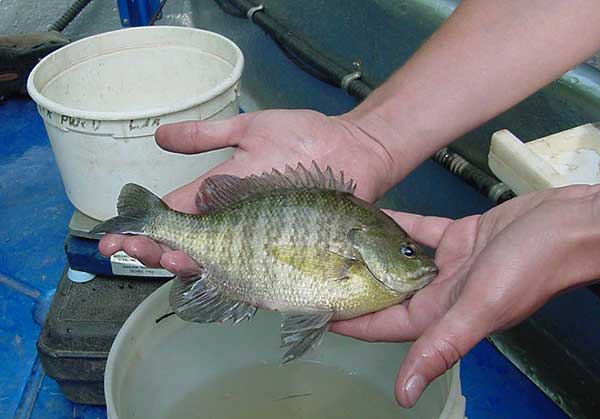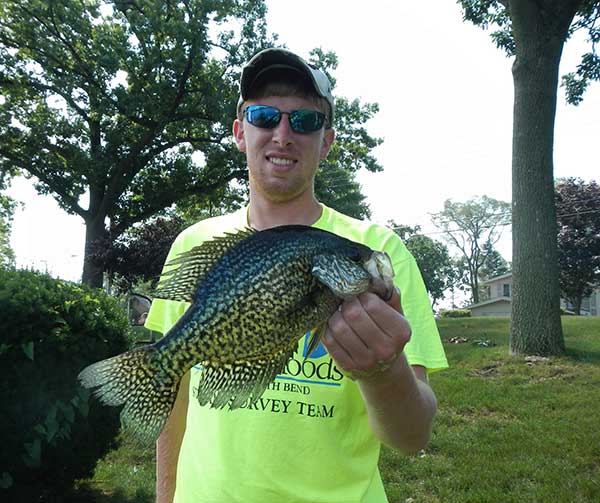By Louie Stout
 Big Bluegill from St. Joseph River
Big Bluegill from St. Joseph River
You may have heard that bluegill fishing on the St. Joseph River has been spectacular in recent years. That’s something you didn’t hear anglers talking about 20 years ago.
Elkhart/South Bend aquatic biologist Dar Deegan says the fishery is dramatically different than it was when his predecessors were studying fish populations two decades ago.
“Back in 1998 when this office started these surveys, the river’s fish community was dominated by suckers but that has changed noticeably over the years,” he said.
The sunfish population has soared while the sucker population has diminished. The river’s sunfish population includes bluegill, rock bass, black crappie and pumpkinseeds.
“From 1998 until 2017 (his last full survey), we’ve seen a 600 percent increase in bluegill numbers,” Deegan described. “During a routine sampling in ’98, we might average picking up 25 bluegills. Now we average around 150.”
Deegan said rock bass once dominated the sunfish population, but bluegills have taken over.
“We’re also seeing more crappie,” he added. “We used to get one or two, now we’re getting 25 or more.”
 Big Black Crappie
Big Black Crappie
Black crappie, he noted, are slightly different than the white crappie more commonly found in reservoirs. Blacks eat mostly insects and small midges while white crappies are more inclined to eat minnows.
The panfish population isn’t likely to change in the near future. The river offers multiple year classes of sunfish, especially bluegill, and Deegan says there is a good “keeper-size” bluegill fishery out there.
“The size structure is pretty good,” he said. “I’m not seeing many 9 inchers, but you can go out there and catch plenty of 7 and 8 inchers. There are lots of them out there and they look very healthy.”
Most of the bluegills are found in the impoundment sections, such as above Twin Branch and the Elkhart dams.
“The Twin Branch section has a ton of bluegill and quite a few other species, such as northern pike, bass a few walleyes,” he said.
Although crappie populations are growing, Deegan pointed out that crappies tend to be very cyclical, meaning they produce strong year classes every four or five years.
Why the change?
The increase in the sunfish family population is certainly good news but Deegan expressed concerns about the diminishing sucker population. There are 10 different species of suckers in the river but most are of the “red horse” variety.
Suckers are sensitive to water quality issues. They do best in cleaner waters.
“Back in the ‘90s, we’d get 300 different suckers on a survey run,” he said. “Now we see about 100, so those numbers have plummeted.”
Suckers aren’t considered a gamefish, nor are the dozens of other species that Deegan and his crew assess each year. But each native critter plays a role in the eco-system and studying the non-sport fish helps Deegan monitor water quality and the overall river condition.
There’s no doubt that efforts to clean up the river from sewage treatment and industrial plant pollution have paid off on the St. Joe. But it’s non-point pollution that could be attributing to water quality changes.
“The water quality isn’t getting worse but something is driving changes in the amount of nutrients (nitrogen and phosphorous) we’re seeing in the river,” he said.
Non-point pollution usually consists of run-offs from lawns, agricultural areas and even parking lots that lie around the river’s watershed.
The river is getting fertilized.
That might explain why aquatic vegetation has exploded in the St. Joe, which, at one time, only had limited shoreline vegetation. Today, you can find various aquatic plants growing on shallow flats in the middle of the river.
That plant life is a benefit to bluegill population but the increase in nutrients could be a detriment to the suckers and the overall future health of the river.
“We’re dealing with a really complex river that has 12 major dams and several lake-type environments mixing with river environments, so some fish species like the prefer one over the other,” Deegan explained. “We have floods and droughts that impact the system; we also saw the introduction of gizzard shad (not native to the river) in 2003 and non-native zebra mussels in 2003. All of this has happened in the past 20 years. So it’s hard to tell what’s driving these (fish population) changes, but it’s probably an interacting effect from all these variables.”
Not every urban community has a biological team assigned to monitor its river systems and uncover these nuances that could impact the future.
It’s good to know that we have someone like Deegan staying on top of it.


